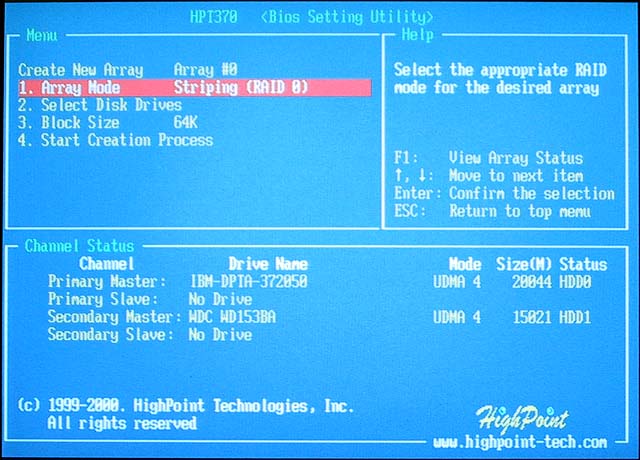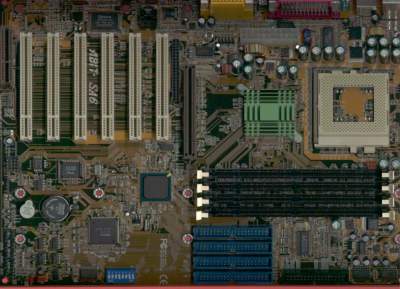ABIT SA6R Socket-370 i815E + RAID ATX
by Henry Kuo on November 13, 2000 2:09 PM EST- Posted in
- Motherboards
Released in June, the Intel i815/i815E chipsets was intended to take over the 440BX and i820 market. The i815/i815E chipsets officially support processors and memory running at 133MHz, unlike the 440BX that required overclocking the AGP bus in order to run your memory and CPU at 133 MHz. Further, the 440BX chipset does not support Ultra ATA 66/100 (without an external controller), while the i815/i815E support Ultra ATA 66/100, respectively. On the other hand, the Intel i820 chipset supports processors running at 133MHz FSB, but it uses expensive Rambus RDRAM, which does not give much of a performance boost in today's applications. Therefore, despite being targeted at the value market, the i815/i815E could still replace the aging 440BX chipset and the expensive i820 chipset.
Even though the release of the Intel Pentium 4 processors and the new i850 chipset is around the corner, it does not mean the i815/i815E era has come to an end. Intel stated in their roadmap that they would continue to release Pentium 3 processors throughout 2001. Since the i850 chipset will not support Pentium 3, that means the i815E chipset will most likely continue to live, unless Intel releases yet another new chipset, which is unlikely. The i815 chipset will probably be history since the i815E chipset is virtually identical, but adds support for Ultra ATA 100 and a couple other new features.
What we're seeing now is the second wave of i815E boards. Just like the good old 440BX chipset, companies will add features, tweak performance, and increase reliability. ABIT is definitely one of those companies. Go back to their 440BX era, and you will see that they released a total of 10 motherboards with that chipset. Therefore, you can also expect to see quite a few variations using the i815E chipset from ABIT.
Four months ago, ABIT released the SE6 - a pretty average i815E motherboard overall. It was released with the older SoftMenu II and the board was not as stable as some others that found their way into the AnandTech labs. For their second-generation product, ABIT has released the SA6R. Think of it as an updated version of the SE6, with some more tweaks as well as features. But the question remains: can the SA6R live up to the expectations of all hardware enthusiasts?
|
ABIT SA6R Specifications |
|
| CPU Interface |
Socket-370
|
| Chipset |
i815E
HighPoint HPT370 Ultra ATA 100 RAID |
| L2 Cache |
N/A
(on-chip)
|
| Form Factor |
ATX
|
| Bus Speeds |
50
- 96 MHz (2:3:1) (in 1MHz increments)
50 - 140 MHz (3:3:1) (in1MHz increments) 50 - 250 MHz (4:3:1) (in 1MHz increments) 50 - 250 MHz (4:4:1) (in 1MHz increments) |
| Voltages Supported |
Auto
Detect
1.30 - 1.90V (in 0.05V increments) |
| Memory Slots |
4
168-pin DIMM Slots
|
| Expansion Slots |
1 AGP Slot
6 PCI Slots (5 Full Length) 1 CNR Slot (1 Shared) 0 ISA Slots |
| Onboard Sound |
Avance
Logic ALC200 AC'97 CODEC
|
| BIOS |
Award
Modular BIOS 6.00PG
ABIT SoftMenu III |
The Good
The first thing you notice when looking at the SA6R is that it is using quite a hefty PCB, about 12 by 9.5 inches. Compared to the original SE6, which is about 12 by 8 inches, the SA6R immediately poses a potential problem for users with smaller cases. ABIT had to use such a large PCB simply because they need the space to put in all those new features. You can see that the board is very "busy," in the sense that there are traces everywhere; therefore, although ABIT is using a large PCB, they are not merely wasting space.
Just like the SE6, the ATX power supply connector is placed next to the serial / parallel connectors. That means the power cables will have to run over the CPU as well as the memory, which may cause an airflow problem. As recent processors generate considerable amount of heat, cooling has become one of the essential parts of system stability. Having the power cables running on top of the CPU may block ventilation, which in turn builds up heat around the CPU.
 However,
the main reason ABIT has gone with the larger PCB on the SA6R is to put in an
extra RAID controller (as well as the two additional IDE connectors that come
with such a controller). ABIT used the Highpoint HPT370 Ultra ATA 100 IDE RAID
controller in their BX133-RAID and
KT7-RAID, so it's no surprise to see
it again on the SA6R. So far hard drive, being one of the slowest component,
is one of the biggest bottleneck of the computer system. Faster and faster hard
drives are coming out every day, but a RAID setup can make them even faster.
However,
the main reason ABIT has gone with the larger PCB on the SA6R is to put in an
extra RAID controller (as well as the two additional IDE connectors that come
with such a controller). ABIT used the Highpoint HPT370 Ultra ATA 100 IDE RAID
controller in their BX133-RAID and
KT7-RAID, so it's no surprise to see
it again on the SA6R. So far hard drive, being one of the slowest component,
is one of the biggest bottleneck of the computer system. Faster and faster hard
drives are coming out every day, but a RAID setup can make them even faster.
The first RAID configuration, RAID 0, takes advantage of drive "striping" and thus requires two hard drives. It sends and receives data to and from the two hard drives in parallel, thus speeding up the overall performance. The second configuration, RAID 1, mirrors a hard drive, obviously also requiring two hard drives. The data on one drive is duplicated on the second drive, therefore increasing the reliability of the system. The third function that the Highpoint controller support is a combination of RAID 0 and RAID 1, aptly named RAID 0+1. It requires 4 hard drives, but it increases both performance and reliability. ABIT also includes the drivers for the controller under Windows 9x, Windows NT, as well as Windows 2000, so compatibility should not be a problem for most users.












2 Comments
View All Comments
Sapnaoberoi1 - Friday, September 11, 2020 - link
Sapna oberoi is a famous delhi escortshttps://sapnaoberoi.com/
Mahipalpur escorts for you
https://sapnaoberoi.com/mahipalpur-escorts.html
Vasant Kunj escorts for you
https://sapnaoberoi.com/escort-service-in-vasant-k...
Karol bagh call girl
https://sapnaoberoi.com/karol-bagh-escorts.html
siya4521 - Wednesday, October 28, 2020 - link
Most Delhi Russian models see nude pic click nowhttp://www.russianescortservicesdelhi.com
https://www.realescortsservicedelhi.in/